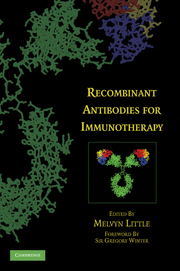Book contents
- Frontmatter
- Contents
- Contributors
- Foreword by Sir Gregory Winter
- Preface
- RECOMBINANT ANTIBODIES FOR IMMUNOTHERAPY
- PART I HUMANIZED ANTIBODIES
- PART II GENERATION AND SCREENING OF ANTIBODY LIBRARIES
- PART III TRANSGENIC HUMAN ANTIBODY REPERTOIRES
- PART IV ANTIBODY EFFECTOR FUNCTION
- PART V ARMING ANTIBODIES
- 12 Monoclonal Antibodies for the Delivery of Cytotoxic Drugs
- 13 Immunotherapy with Radio-immune Conjugates
- 14 Immunotherapeutic Antibody Fusion Proteins
- PART VI NOVEL ANTIBODY FORMATS
- PART VII ANTIGEN-BINDING REPERTOIRES OF NON-IMMUNOGLOBULIN PROTEINS
- PART VIII PROLONGATION OF SERUM HALF-LIFE
- PART IX INNOVATIVE IMMUNOTHERAPEUTIC APPROACHES
- PART X MARKET OVERVIEW AND OUTLOOK
- Index
- Plate section
- References
14 - Immunotherapeutic Antibody Fusion Proteins
from PART V - ARMING ANTIBODIES
Published online by Cambridge University Press: 15 December 2009
- Frontmatter
- Contents
- Contributors
- Foreword by Sir Gregory Winter
- Preface
- RECOMBINANT ANTIBODIES FOR IMMUNOTHERAPY
- PART I HUMANIZED ANTIBODIES
- PART II GENERATION AND SCREENING OF ANTIBODY LIBRARIES
- PART III TRANSGENIC HUMAN ANTIBODY REPERTOIRES
- PART IV ANTIBODY EFFECTOR FUNCTION
- PART V ARMING ANTIBODIES
- 12 Monoclonal Antibodies for the Delivery of Cytotoxic Drugs
- 13 Immunotherapy with Radio-immune Conjugates
- 14 Immunotherapeutic Antibody Fusion Proteins
- PART VI NOVEL ANTIBODY FORMATS
- PART VII ANTIGEN-BINDING REPERTOIRES OF NON-IMMUNOGLOBULIN PROTEINS
- PART VIII PROLONGATION OF SERUM HALF-LIFE
- PART IX INNOVATIVE IMMUNOTHERAPEUTIC APPROACHES
- PART X MARKET OVERVIEW AND OUTLOOK
- Index
- Plate section
- References
Summary
The discovery of the monoclonal antibody technology by Milstein and Kohler paved the way for antibodies of desired specificity to be made in quantities that could enable large clinical trials, and heralded the start of the antibody targeted-therapy era. Numerous clinical trials were conducted using murine antibodies derived from the spleen cells of immunized mice and myeloma cells. A major drawback to the use of these murine, xenogeneic antibodies in man was the development of a human anti-murine antibody response (HAMA) against both the constant and variable regions of the antibody. This response rarely led to anaphylactic or other hypersensitivity reactions but did severely limit the number of administrations that could be made, and hence it often negated the therapeutic efficacy of these antibodies.
Studies in a number of laboratories paved the way to humanizing these murine antibodies (see chapter by Saldanha) and, as the advances in antibody technology increased, fully human antibodies with high affinity have been developed for clinical use. Today, antibodies are by and large combined with chemotherapeutics, and in this setting, have been shown to improve both the time to disease progression and survival in patients with a wide spectrum of tumors. Combination therapy in oncology is an established protocol, as it is necessary to target various molecular events of the tumor cell as well as antigens preferentially expressed by such tumor cells.
- Type
- Chapter
- Information
- Recombinant Antibodies for Immunotherapy , pp. 190 - 200Publisher: Cambridge University PressPrint publication year: 2009

